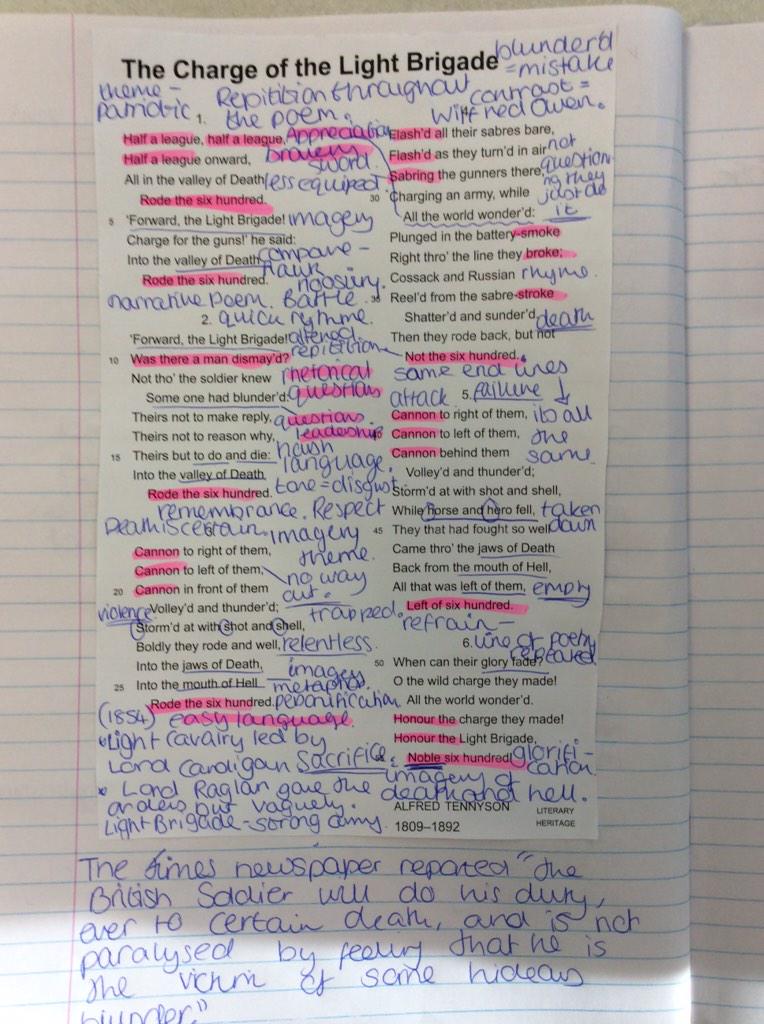

Furthermore, Owen’s men suffer more through the silence, while Tennyson’s poem shows the noise of the horses and action. Exposure, by Owen focuses on war through the harsh weather conditions, while Tennyson in Charge of the Light Brigade reflects on how emotionless the men appear in comparison to Owen’s bleak depiction of the men’s suffering. Owen and Tennyson focus on the experiences of the men in war and their experiences in different ways. How does Owen in Exposure reflect on the experiences of war, compared to one other poem in the Anthology? I’m sure it isn’t perfect, but hopefully it is useful. A worked example of a comparison between the two poems Exposure and The Charge of the Light Brigade. This is the finished version of what I was working on at the same time as the students. Tennyson questions the legacy of the Light Brigade and the shear bravery they displayed on the ‘wild charge’ and calls for the reader to honour the ‘noble men’ and their legendary, albeit doomed, charge.Earlier today I reflected on the revision session with my tutoring group: Why I love…Comparing poems – The Process of teaching comparison – COTLB & Exposure The sixth stanza shifts from the narrative tone of the previous five to a more reflective one.

The fifth stanza then repeats the third, albeit now describing the Brigade retreating with the guns behind them – the men, or ‘all that was left of them’ are now fleeing for their lives as opposed to their initial valiant charge. Tennyson then depicts the Light Brigade retreating, but not in their original number – many men have been lost in the fatally, doomed charge. Despite their doomed position, the Light Brigade fight valiantly against the ‘Cossack and Russian’ enemy breaking through their line of defense and managing to strike a number with their swords. In the fourth stanza, the soldiers helplessly attempt to fight back at the Russian artillery with ‘their sabres bare’ (old-fashioned swords) which are obviously no match for the Russian guns. Despite this, it’s evident of Tennyson’s admiration for the men’s bravery and strength, recounting their riding well ‘into the mouth of hell’. Tennyson’s use of spatial imagery when describing the cannons surrounding the men highlights the extent to which they are outnumbered and overwhelmed. The third and fourth stanzas describe the bombardment ‘with shot and shell’ inflicted upon the Light Brigade fired by the Russian artillery that they are charging towards. In this stanza the, ultimately fatal, ignorance and vulnerability of the men is commented upon – ‘Theirs not to make reply,/Theirs not to reason why,/Theirs but to do and die.’ The mercy of the soldiers is beyond them, dictated by, on this occasion misunderstood, orders of their seniors – their only role is ‘to do and die.’

The man instructing the troop to “charge for the guns” is Lord Cardigan giving these orders based on a miscommunication in the chain of command, which Tennyson picks up on in the second stanza saying ‘someone had blundered’. The first stanza narrates the beginning of the charge, describing the brigade of 600 men charging ‘half a league’ or about 1.5 miles through the ‘Valley of Death’ towards the ‘guns’ of the Russian artillery.

The ‘Charge of the Light Brigade’ written by Alfred, Lord Tennyson narrates the events when British troops fatally charged directly at the Russian artillery during the Battle of Balaclava in the Crimean War six weeks prior on the 25 th October 1854.


 0 kommentar(er)
0 kommentar(er)
